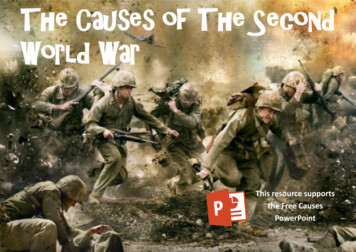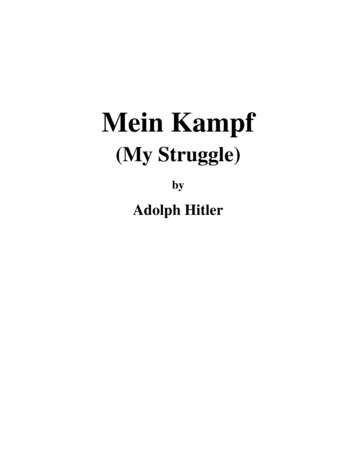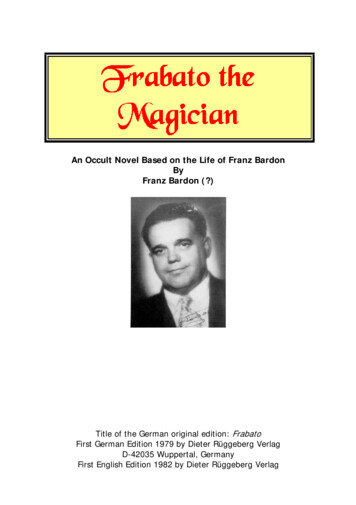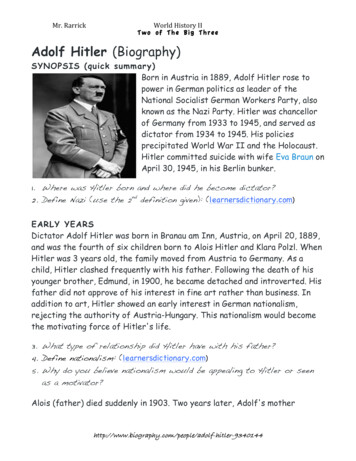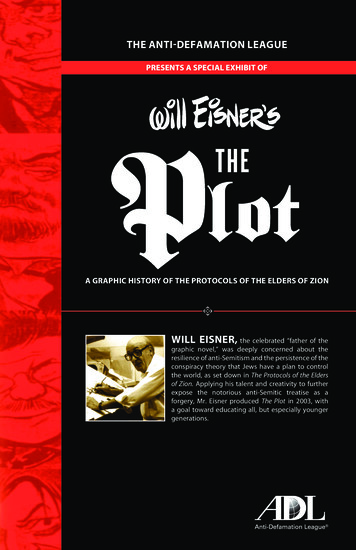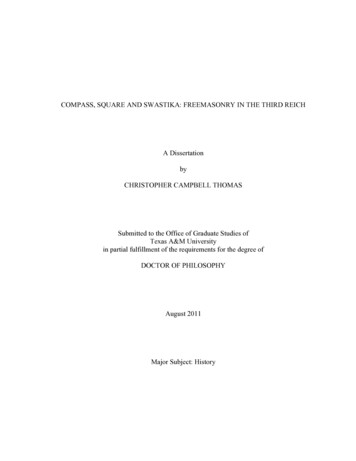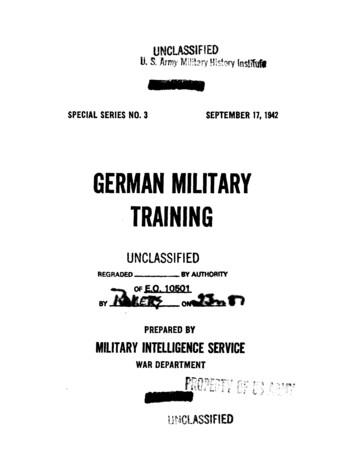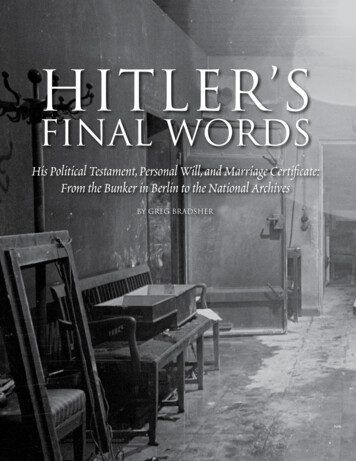
Transcription
HITLER’SFINAL WORDSHis Political Testament, Personal Will, and Marriage Certificate:From the Bunker in Berlin to the National ArchivesBY GREG BRADSHER
The documents featured in the National Archives Exhibit Hall in April 1946were unlike any displayed there before. They were not pages from America’sdistant past, pages that Americans make once-in-a-lifetime pilgrimages toWashington to gaze upon, or documents with the signatures of our Founding Fathers.These documents had been created less than a year before and had been in Germanhands just four months earlier.Visitors to the Archives beheld the tangible proof of theend of World War II—the military surrender documents—and the last documents signed by Adolf Hitler: his mar riage certificate, political testament, and personal will.The travels of the Hitler documents from deep in thefuehrer’s underground bunker in Berlin to the NationalArchives began in late April 1945, when Russian forceswere on the verge of capturing the city.On the evening of April 28, Adolf Hitler, Germany’sReich chancellor and president, had a lot on his mind.News had arrived during the day that there had been anuprising in northern Italy; Benito Mussolini had been ar rested by the partisans; armistice negotiations were beinginitiated by some of Hitler’s military commanders in Italy;and there had been an attempted coup in Munich.Russian forces were only some 1,000 yards from the bun ker, and the German Ninth Army, which had been orderedto break through the Russian-encircled capital of the Reichto rescue Hitler would most likely not to be able to accom plish its mission. Still, Hitler held a slim hope that Gen.Walther Wenck’s 12th Army, heading toward Potsdam andBerlin, would succeed.Nevertheless, Hitler knew that he soon would have tocommit suicide. Before doing so, he wished to marry hislong-time mistress, Eva Braun, and write his final politicaltestament and personal will.As the evening progressed, Hitler received confirmation thatHeinrich Himmler, the head of the SS, was negotiating withthe Western Allies. In response, Hitler ordered Eva Braun’sbrother-in-law, SS-Gruppenfuehrer Hermann Fegelein,Himmler’s liaison to Hitler, executed for desertion and treason.“Come along ,” he said,“I want to dictate something.”Hitler’s secretary, 25-year-old Gertrude Junge, tried thatevening to sleep for an hour. Sometime after 11 p.m., shewoke up. She washed, changed her clothes, and thought itmust be time to drink tea with Hitler, the other remainingsecretary (31-year-old Frau Gerda Christian), and Hitler’s veg etarian cook (25-year-old Fraulein Constanze Manzialy), ashad become a nightly occurrence. When she opened the doorto Hitler’s study, Hitler came toward her, shook her hand, andasked, “‘Have you had a nice little rest, child?’” Junge replied,“Yes, I have slept a little.” He said, “Come along, I want to dic tate something.” This was between 11:30 p.m. and midnight.They went into the little conference room near Hitler’squarters. She was about to remove the cover from the type writer, as Hitler normally dictated directly to the typewrit er, when he said, “Take it down on the shorthand pad.” Shesat down alone at the big table and waited. Hitler stood inhis usual place by the broad side of the table, leaned bothhands on it, and stared at the empty table top, no longercovered that day with maps.For several seconds Hitler did not say anything. Then,suddenly he began to speak the first words: “My politicaltestament.”Opposite: Part of the conference area in Hitler’s underground bunker.Left: Hitler ended his personal will by stating that he and his wife “choosedeath to escape the disgrace of being forced to resign or surrender.”The will is dated April 29, 1945, and witnessed by Bormann, Goebbels,and Von Below.
As Hitler began speaking, she had theimpression that he was in a hurry. “In tonesof indifference, almost mechanically, theFuehrer,” Junge would later observe, “comesout with the explanations, accusations anddemands that I, the German people and thewhole world know already.”After finishing his political testament, ac cording to Junge, Hitler paused a brief mo ment and then began dictating his privatewill. Hitler’s personal will was shorter. Itexplained his marriage, disposed of his prop erty, and announced his impending death.The dictation was completed. Hitler hadnot made any corrections on either docu ment. He moved away from the table onwhich he had been leaning all this timeand said, “Type that out for me at once intriplicate and then bring it in to me.” Jungefelt that there was something urgent in hisvoice, and thought about the most impor tant, most crucial document written byHitler going out into the world without anycorrections or thorough revision. She knewthat “Every letter of birthday wishes to someGauleiter, artist, etc., was polished up, im proved, revised—but now Hitler had notime for any of that.”Junge took her notepad and typewriteracross the hall to type up the political andpersonal wills. The room she used was nextto Reichs Minister of Propaganda JosephGoebbels’s private room. There she begantyping up her shorthand notes of the twodocuments, knowing that Hitler wanted herto finish as fast as possible.An Early Morning CeremonyWith Just a Few FriendsThe next item of business was the HitlerBraun marriage. Once Junge departed theconference room, guests began entering toattend the wedding ceremony. In the mean time, Hitler was in his sitting room witha few people, trying to get the weddingready in a dignified way, while the confer ence room was turned into a registry officeand set up for the ceremony. SS-Maj. HeinzLinge (Hitler’s valet since 1935) began get ting things ready for the post-wedding cer emony, including gathering up food anddrink for Hitler’s inner circle.Meanwhile, Goebbels, in his capacity ofgauleiter of Berlin, knew of someone autho rized to act as a registrar of marriage who wasstill in Berlin, fighting with the Volkssturm,a last-ditch military organization establishedby the Nazi Party in October 1944. He wasa 50-year-old municipal councilor namedWalter Wagner. A group of SS men was dis patched across the city to bring him back.Wagner appeared shortly before 1 a.m. onApril 29 in the uniform of the Nazi Partyand the armband of the Volkssturm. The cer emony took place probably at some point be tween 1 a.m. and 2 a.m. Hitler and Braun lefttheir apartment hand in hand and went intothe conference room. Hitler’s face was ashen,his gaze wandered restlessly. Eva Braun wasalso pale from sleepless nights. Goebbels andMartin Bormann, the head of the Nazi Partychancellery and private secretary to Hitler,were waiting for them in the antechamber.In the conference room, Hitler and Evagreeted the functionary who had taken uphis position at the table. Then they sat downin the first two chairs, and Bormann andGoebbels went to their assigned places. Thedoor was closed. The two parties declared thatthey were of pure Aryan descent and were freefrom hereditary disease. In a few minutes theparties had given assent, the register had beensigned, and the ceremony was over. When thebride came to sign her name on the marriagecertificate, she began to write “Eva Braun”but quickly struck out the initial letter Band corrected it to “Eva Hitler, nee Braun.”Bormann, Goebbels, and Wagner also signedthe register as witnesses. The ceremony lastedno longer than 10 minutes.Bormann opened the door again whenHitler and Eva were signing the license. Hitlerthen kissed Eva’s hand. They went into theconference passage, where they shook handswith those waiting. They then withdrew intotheir private apartments for a wedding break fast. Shortly afterward, Bormann, Goebbels,Magda Goebbels, and the secretaries Christianand Junge were invited into the private suite.Left: Adolf Hitler and Eva Braun, ca. 1942. Right: A plan of Hitler’s underground bunker near the Reich Chancel lery in Berlin, Germany, shows Hitler’s study (A), anteroom (B), bedroom (C), and “map room” (D). Adaptedfrom a plan of the bunker in Hugh Trevor-Roper’s The Last Days of Hitler (6th ed., 1992).ACBD
Junge would not come right away as she wastyping across the hall. At some point duringthe party, Junge walked across the corridor toexpress her congratulations to the newlywedsand wish them luck. She stayed for less than15 minutes and then returned to her typing.For part of the time, General of InfantryHans Krebs, Lt. Gen. Wilhelm Burgdorf,and Lt. Col. Nicholaus von Below (Hitler’sLuftwaffe adjutant) joined the party, as didWerner Naumann (state secretary in theMinistry of Propaganda), Arthur Axmann(Reich youth leader), Ambassador WalterHewel (permanent representative of ForeignMinistry to Hitler at Fuehrer headquarters),Hitler’s valet Linge, SS-Maj. Otto Guensche(personal adjutant to Hitler), and Manzialy,the cook. They sat for hours, drinking cham pagne and tea, eating sandwiches, and talking.Hitler spoke again of his plans of suicide andexpressed his belief that National Socialismwas finished and would never revive (or wouldnot be resurrected soon), and that deathwould be a relief to him now that he had beendeceived and betrayed by his best friends.The Party Goes OnAs the Russians NearHitler left the party three times to ask howJunge had gotten in her typing. Accordingto Junge, Hitler would look in and say “Areyou ready?” and she said, “No my Fuehrer, Iam not ready yet.” Bormann and Goebbelsalso kept coming to see if she was finished.These comings and goings made Junge ner vous and delayed the process, increasing herdistress about the whole situation, and shemade several typographical errors. Thosewere later crossed out in ink.Also complicating her task was the needto add to the political testament the namesof some appointments of the new govern ment under Adm. Karl Doenitz. During thecourse of the wedding party, Hitler discussedand negotiated the matter with Bormannand Goebbels. While Junge was typing theclean copies of the political testament fromHitler's Final Wordsher shorthand notes, Goebbels or Bormanncame in alternately to give her the names ofthe ministers of the future government, a pro cess that lasted until she had finished typing.Toward 5 a.m., Junge typed the last of thethree copies each of the political testament andpersonal will. They were timed at 4 a.m., as thatwas when she had begun typing the first copyof the political testament. Just as she finished,Goebbels came to her for the documents, al most tearing the last piece of paper from thetypewriter. She gave them to him without hav ing a chance to review the final product. Sheasked Goebbels whether they still wanted her,and he said, “no, lie down and have a rest.” Thewedding party was ending, and Goebbels tookthe copies of the documents to Hitler.The documents were ready to be signed.First Hitler signed the personal will, followedby the witnesses Bormann, Goebbels, andvon Below. Hitler and witnesses Goebbels,Bormann, Burgdorf, and Krebs then signedthe political testament.At around 6 a.m. on April 29, Russian artil lery began its regular intense bombardment ofthe government district and the area aroundthe Reich Chancellery. The front line was nowonly about 450 yards from the chancellery.During those early morning hours, Hitlerplanned for the three copies of his personaltestament and personal will to be taken outof Berlin and delivered to Admiral Doenitzand Field Marshal Ferdinand Schoerner,commander of the Army Group Center inBohemia (and, by way of Hitler’s politicaltestament, newly appointed commander-in chief of the army).Three couriers set out from Berlin to crossenemy lines, each carrying a copy of the po litical testament and personal will. Maj. WillyJohannmeier was Hitler’s army adjutant; SSCol. Wilhelm Zander, an aide representingBormann; and Heinz Lorenz, an official of thePropaganda Ministry representing Goebbels.Johannmeier was sent to Schoerner; Zanderto Doenitz, carrying the marriage certificate aswell as the testament and will. Bormann’s coverletter to Doenitz stated: “Dear Grand Admiral,Since all divisions have failed to arrive, and ourposition seems hopeless, the Fuehrer dictatedlast night the attached political Testament.Heil Hitler.—Yours, Bormann.”Lorenz received his package fromGoebbels, but it is unclear where Goebbelstold him to take the documents. It seems thathe was to take them to Doenitz if possible,or to the nearest German High Command.If all else failed, he was to publish the willsfor historical purposes and ultimately storethem at the party archives in Munich.Hitler told Johannmeier that this testa ment must be brought out of Berlin at anyprice, that Schoerner must receive it, andthat he believed Johannmeier would succeedin the task. Hitler spoke very cordially andshook his hand. They both realized that theywould not see each other again.Hitler Commits Suicide;Allies Capture DocumentsThe Russian attack drew relentlessly nearthe bunker. At about 9 a.m., the artillery firesuddenly stopped, and runners reported tothe bunker that the Russians were advancingwith tanks and infantry. It grew silent in thebunker, and there was great tension amongits occupants.Later on that morning Junge went back toHitler’s bunker. She noted that Hitler was un easy and walked from one room to another.Hitler told her he would wait until the couri ers had arrived at their destinations with thetestaments and then would commit suicide.At noon, with the Russians closing inon the bunker, Hitler held a situation con ference with Bormann, Krebs, Burgdorf,Goebbels, and a few others. At the sametime, the three couriers joined by Cpl.Heinz Hummerich (a clerk in the adjutancyof the fuehrer headquarters), left the bunkerand headed west.The following afternoon, Hitler and EvaBraun committed suicide in the bunker inBerlin. On May 1 at 2:46 p.m., GoebbelsPrologue 19
sent Doenitz a message that Hitler had diedat 3:30 p.m. on April 30, and that his testa ment of April 29:appoints you as Reich President,Reich Minister Dr. Goebbels as ReichChancellor, Reichsleiter Bormann asParty Minister, Reich Minister SeyssInquart as Foreign Minister. By orderof the Fuehrer, the Testament has beensent out of Berlin to you, to FieldMarshal Schoerner, and for preservationand publication. Reichsleiter Bormannintends to go to you today and to in form you of the situation. Time andform of announcement to the Press andto the troops is left to you. Confirmreceipt.—Goebbels.Six hours later, Goebbels killed himself.At 10:26 p.m. May 1, Doenitz, overHamburg Radio, announced Hitler’s deathand his own succession.As Berlin surrendered, the three cou riers made their way to Potsdam andBrandenburg. On May 11 they crossedthe Elbe at Parey, between Magdeburg andGenthin, and under the guise of foreignworkers, passed into the area of the WesternAllies, transported by American trucks. Bythis time the war was over, and Zander andLorenz lost heart and easily convinced them selves that their mission now had no purposeor possibility of fulfillment. Johannmeier al lowed himself to be influenced by them, al though he still believed he would have beenable to complete his mission.After abandoning their mission, themen split up. Zander and Lorenz went tothe house of Zander’s relatives in Hanover.From there, Zander proceeded south untilhe reached Munich, where he stayed withhis wife, and then continued to Tegernsee.At Tegernsee, Zander hid his documents ina trunk. He changed his name, identity, sta tus, and began a new life under the nameof Friedrich Wilhelm Paustin. Johannmeiermeanwhile went to his family’s home inIserlohn in Westphalia, and buried his20 Prologuedocuments in a bottle in the back garden.Lorenz ended up in Luxembourg and foundwork as a journalist under an assumed name.Lorenz and the documents he was carry ing were seized by the British Army, in theBritish Zone of Occupation of Germany, inNovember 1945. The Americans capturedZander and his documents (including theoriginal marriage license of Hitler and Braun,and the handwritten transmittal letter fromBormann to Doenitz) with the assistance ofBritish intelligence officer Maj. Hugh TrevorRoper, in Bavaria on December 28.After Zander’s arrest, interest switched toJohannmeier, who had been living quietlywith his parents in Iserlohn, in the BritishZone of Occupation. Trevor-Roper had himdetained and interrogated on December 20.Johannmeier maintained that he had nodocuments but had just escorted Zanderand Lorenz out of Berlin. Trevor-Roper metwith Johannmeier on January 1, 1946, andexplained to him that Zander and Lorenzwere both in Allied hands and that in viewof their independent but unanimous testi mony, it was impossible to accept his state ment that he had been merely an escort. Henevertheless maintained his story. He agreedthat the evidence was against him but insist ed that his story was true.Asked if he could name any witness whosetestimony might offset that of Zander andLorenz, he stated that he had spoken to noone about his mission, and that the onlyman who knew the details was the man whohad given it to him—Lt. Gen. WilhelmBurgdorf. When told that Burgdorf wasmissing and believed dead, Johannmeier ex claimed, “Then my last hope is gone.”The position was put sympathetically toJohannmeier: that he must realize that thedocuments were already in Allied hands, andanother revelation could add nothing to theirknowledge, and continued resistance to theevidence would entail his imprisonment. Butstill Johannmeier insisted that his story was thetruth. He agreed to sign a written declarationto that effect. “If I had the documents, it wouldbe senseless to withhold them now, but what Ihave not I cannot deliver. I cannot even provethat I have not got them?” His otherwise un accountable persistence in this story, by whichhe was condemning himself to imprisonmentfor no conceivable advantage to anyone, andby the ingenuousness of his protestations,Johannmeier had almost persuaded TrevorRoper that there must after all be some flawin the evidence against him, some element oftruth in his improbable but unshakeable story.They were alone in the headquarters; every one else had left for the holiday. Trevor-Roperhad nowhere to put Johannmeier. He decidedthat he must admit failure and summon atruck to take him away. But when he left theroom for two hours for a long-distance phonecall, Johannmeier had leisure to think.When Trevor-Roper returned and beganthe mechanical questioning again, he becameaware of a change in Johannmeier’s attitude.Johannmeier, according to Trevor-Roper,seemed to have already resolved his mentaldoubts, and after a little preliminary and pre cautionary fencing, in which he sought as surance that he would not be penalized if herevealed his secret about the documents, hedeclared, “I have the papers.” He stated thathe had buried them in a garden of his homein Iserlohn, in a glass bottle, and he agreed tolead Trevor-Roper to the spot.Allies Debate FateOf Hitler’s PapersOn the long drive back to Iserlohn,Johannmeier spoke freely on various topics.When they stopped for a meal, Trevor-Roperasked him why he had decided to reveal thetruth. Johannmeier said he had reflectedthat if Zander and Lorenz had so easily con sented to betray the trust reposed in them,it would be quixotic for him, who was nota member of the party or connected withpolitics but merely carrying the documentsin obedience to a military order, to endurefurther hardship to no practical purpose.Spring 2015
Left: The identification page from the marriage certificate for Hitler and Eva Braun (English translation) quickly completed in the bunker the day before their suicideas Russian forces closed in. Right: The marriage certificate’s signature page bears the signatures of Hitler, Braun, Goebbels, and Bormann.In Iserlohn they left the car some distanceaway at Johannmeier’s request—he did notwant the neighbors to see a British staff caroutside his parents’ home. It was now nightand the ground had frozen hard. Togetherthey walked out to the back corner of hisgarden. Johannmeier found the place, brokefrozen surface of the ground with an axe, anddug up the glass bottle. Then he smashed thebottle, drew out the documents, and handedthem over to Trevor-Roper. They were thethird copy of Hitler’s private will and per sonal testament plus a cover letter fromBurgdorf to Schoerner.The Allies now had the three sets of docu ments that had been carried out of the bun ker in April.Early in the new year, Foreign ServiceOfficer J. D. Beam wrote AmbassadorRobert Murphy, U.S. political adviser forGermany, that Col. S. Frederick GronichHitler's Final Words(the officer in charge of the DocumentsControl Center at Frankfurt) had broughtto him that day (January 2, 1946), copies ofHitler’s will and marriage license.Beam observed that they were highly in teresting documents and seemed altogetherauthentic. He indicated that G-2 was send ing the original documents to Washington,where they might be deposited with theLibrary of Congress. This action was beingtaken, he noted, to forestall any demandsfrom other countries for custody of thedocuments. Beam reported that photostaticcopies had been made and that Murphy’s of fice was to be furnished with two.On January 3, 1946, Brig. Gen. Edwin L.Sibert, G-2, U.S. Forces European Theater(USFET) telephoned Lt. Col. Harold H.May, intelligence chief of G-2, Third U.S.Army, to ask if they had published the re cently discovered Hitler documents. Mayanswered that they had put out only a gen eral release about the papers. Sibert said thatthe British had been making statementsto the effect that they would soon publishthem and wondered what had happened tothe original translations of these documents.May informed him that they were at theExecutive Branch, G-2, Third Army. Sibertrequested that G-2 keep the contents secret.In a January 4 cable to the State Department,Murphy reported the circumstances of thecapture of the will and other documents asrelated to his office by G-2 USFET. Murphyadded that Zander was last reported to be incustody in Munich and that G-2 accepted theauthenticity of the documents. He indicatedthat with his concurrence, the original docu ments were being forwarded shortly to theWar Department for possible later custodyby the Library of Congress and that it wasunderstood that photostatic copies would bePrologue 21
Left: Hitler composed his political testament in his last hours (English translation shown) with a transfer of power to those officers he still trusted. He designatedDoenitz as Reichs President, Goebbels as Reichs Chancellor, and Bormann as Party Minister. Right: A January 11, 1946, letter from G2, Third U.S. Army, to the U.S.Chief of Counsel, International Military Tribunal at Nuremberg transmitted photocopies of the Hitler documents and a summary of how British and American officersrecovered them from Wilhelm Zander, an adjutant to Martin Bormann.given to other interested Allied nations andthat he was to receive a copy, which he wouldsend to the State Department.Four days later, Beam sent a dispatch to theState Department that included a copy of areport received by G-2 USFET regarding thediscovery of Hitler’s political testament andother documents found with Zander. Beamreported that the original documents wereon their way to the War Department. Headded that there were probably three signedoriginals of Hitler’s wills, including the onefound in Bavaria with Zander. The Britishdiscovered the other two copies. The dis patch enclosed translations and photostatsof letters of transmittal, the marriage license,the private will, and the personal testament.Beam surmised that the documents capturedby the United States authorities in Bavariacontained the single original of Hitler’s mar riage certificate.Another letter tracking the whereabouts ofthe Hitler’s documents was sent on January22 Prologue11 from G-2, Third U.S. Army, to the Officeof the U.S. Chief of Counsel, InternationalMilitary Tribunal at Nuremberg. This dis patch included a complete set of photocopiesof documents and photographs discoveredby the 303rd Counterintelligence Corps(CIC) Detachment, Third U.S. Army, onDecember 28, 1945.British Oppose Publicity;The Americans AgreeThe British also had their concerns aboutthe Hitler documents. The British embassyin Washington on January 9, 1946, preparedan aide memoire for the State Departmentstating that while the complete texts ofHitler’s political and personal testamentshad been published in the press, the lesspublic notice the documents received inGermany or elsewhere the better.Further, the British government intendedto avoid any mention of the documents inits propaganda to Germany or Austria. Theembassy then raised the question of the dis posal of the original documents, two sets ofwhich were in British hands and one set inAmerican hands:It is possible that these might in timebecome objects of great sentimentaland political value to many Germanys.[Ernest Bevin, the principal secretaryof state for foreign affairs] is consider ing whether it would not be wise todestroy these sets. This could be doneat any time but meanwhile he intendsthat the British sets should be removedfrom Germany and safely interred inthe British official archives. . . . Mr.Bevin hopes that the State Departmentwill take similar steps and will also agreethat the number of microfilm copiesshould be very strictly limited as well.Even facsimiles might become objectsof veneration and these could be mul tiplied in Germany if a single facsimilecopy got into the wrong hands.Spring 2015
Within a short time of receiving the aidememoire, Dean Acheson, the acting secre tary of state, informed Ambassador Murphyof the British government’s intended plansfor the Hitler documents. While the StateDepartment, Acheson wrote, was not im pressed by the British argument in viewof publication of texts, he asked Murphywhether photostatic copies mentioned in hisJanuary 4 cable had actually been given toother interested Allied nations and whetherthe original set had been forwarded to theWar Department.On January 22 Beam wrote Col. W. D.Hohenthal, chief of the intelligence branch,Office of the Director of Political Affairs,Office of Military Government (U.S.) thatHitler’s political and personal testaments inU.S. hands had been dispatched to the WarDepartment, that copies had been furnishedto the British and French, and that arrange ments were made to provide photostats tonews representatives.On January 24 Murphy wrote the secretaryof state, passing on information in Beam’sreport regarding the Hitler documents.Murphy reported that the U.S. Army recov ery included the only originals of Hitler’smarriage certificate and Bormann’s letter oftransmittal to Doenitz, indicating that this setwas the one intended for despatch to Doenitzby special courier. The British find, he added,included a memorandum by Goebbels and aletter from a German general in Berlin. Hereported that photostatic copies of the abovedocuments were being exchanged with theBritish to complete respective sets and thatG-2 had not yet received an interrogation re port on Zander.With the above information, the StateDepartment crafted a memorandum ac knowledging receipt of the British embassy’saide memoire regarding the disposition ofthe original texts and microfilm copies ofHitler’s political and personal testaments.The memorandum indicated that the StateDepartment agreed with the British ForeignOffice “that the less public notice the docu ments receive in Germany or outside thebetter” and that it had no present intentionof mentioning these documents in broad casts to or in press releases for Germany. TheState Department indicated that it had beeninformed that the original signed texts ofthe documents that were in U.S. hands hadbeen transmitted to the War Departmentand that Murphy reported that the U.S. mil itary authorities arranged to furnish copiesof these documents to the British, Russian,and French military officials, and also to givephotostatic copies to representatives of theAmerican press. Concluding, the memoran dum stated that:The Department recognizes thatit would be undesirable to have fac similes of these documents distributedthroughout Germany. It should be pos sible to prevent such distribution dur ing the period of Allied control overpublications, publishing establishmentsand printing presses in Germany, inview of the release of photostatic cop ies that has already taken place, theDepartment does not see what stepscould be taken at this time to preventfacsimiles from falling into Germanhands at some future date.In a January 25 communication, the chiefof the Military Intelligence Service (MIS)sent photostatic copies of Hitler’s marriagecertificate, personal will, political testamentand allied papers to Maj. Gen. ClaytonBissell, the assistant chief of staff, G-2. Bissellwas informed that MIS had possession of theoriginal documents, which had been evacu ated from Germany. MIS recommendedthat he authorize putting both the originaldocuments and translations in a protectivefolder suitable for presentation, forward allthe materials to the chief of staff for pre sentation to the President, and recommendthat the President permit the documents tobe placed in a public display in the Libraryof Congress. Bissel should also have photo static copies of the documents passed on tothe State Department for presentation to theAllied governments of Russia, France, andGreat Britain. Bissell approved the plan andrecommended that the transmittal to foreigngovernments be done on the secretary of warto secretary of state level.Gen. Eisenhower Asks FBITo Authenticate DocumentsAnother month passed before MIS act ed. In accordance with instructions, a let ter from the chief of staff to the Presidenthad been drafted for transmittal of Hitler’spersonal documents. The State Departmenthad been contacted to determine how manyphotostatic copies of the documents were re quired for their purp
First Hitler signed the personal will, followed by the witnesses Bormann, Goebbels, and von Below. Hitler and witnesses Goebbels, Bormann, Burgdorf, and Krebs then signed the political testament. At around 6 a.m. on April 29, Russian artil lery began its regular intense bombardment of the government district and the area around
